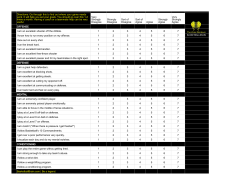
Read the topline questionnaire, including the survey methodology
Public May 7, 2015 Religion Research Institute Q.1 PRRI Religion & Politics Tracking Survey N = 1,003 (503 Landline, 500 Cell phone) April 29 – May 3, 2015 How much, if anything, have you heard about the protest demonstrations and riots in Baltimore after an African American man died while in police custody? 68 24 6 1 100 A lot A little Nothing at all Don’t know/Refused (VOL.) Total Q.2 Now, as I read some statements on a few different topics, please tell me if you completely agree, mostly agree, mostly DISagree or completely disagree with each one. First… [INSERT; RANDOMIZE]. Next… READ FOR FIRST ITEM, THEN REPEAT AS NECESSARY: Do you completely agree, mostly agree, mostly DISagree or completely disagree? a. Police officers generally treat blacks and other minorities the same as whites May 2015 Nov. 20141 12 12 Completely agree 29 33 Mostly agree 29 31 Mostly disagree 23 21 Completely disagree 7 4 Don’t know/Refused (VOL.) 100 100 Total 1 Public Religion Research Institute, Post-‐election American Values Survey, November 2014. RD 2027 MASSACHUSETTS AVE, 3 FLOOR, WASHINGTON, DC 20036 • 202-‐238-‐9424 • WWW.PUBLICRELIGION.ORG Public Religion Research Institute b. Blacks and other minorities receive equal treatment as whites in the criminal justice system May Dec. Sept. Aug. 2 3 2015 2014 2014 20134 15 17 14 22 Completely agree 26 29 24 25 Mostly agree 29 30 30 26 Mostly disagree 22 23 26 21 Completely disagree 8 2 6 6 Don’t know/Refused (VOL.) 100 100 100 100 Total Q.3 Do you think the recent killings of African American men by police in Ferguson, Missouri, New York City, and Baltimore are isolated incidents, OR are they part of a broader pattern of how police treat African Americans? 39 Isolated incidents 49 A sign of a broader problem 13 Don’t know/Refused (VOL.) 100 Total 2 Public Religion Research Institute, Religion & Politics Tracking Survey, December 2014. 3 Public Religion Research Institute, American Values Survey, September 2014. 4 Public Religion Research Institute, Religion & Politics Tracking Survey, August 2013. RD 2027 MASSACHUSETTS AVE, 3 FLOOR, WASHINGTON, DC 20036 • 202-‐238-‐9424 • WWW.PUBLICRELIGION.ORG 2 Public Religion Research Institute 3 Survey Methodology The survey was designed and conducted by Public Religion Research Institute. Results of the survey were based on bilingual (Spanish and English) RDD telephone interviews conducted between April 29, 2015, and May 3, 2015, by professional interviewers under the direction of SSRS. Interviews were conducted among a random sample of 1,003 adults 18 years of age or older living in the United States (500 respondents were interviewed on a cell phone). The selection of respondents within households was accomplished by randomly requesting to speak with the youngest adult male or female currently living in the household. Data collection is based on stratified, single-‐stage, random-‐digit-‐dialing (RDD) sample of landline telephone households and randomly generated cell phone numbers. The sample is designed to represent the total U.S. adult population and includes respondents from all 50 states, including Hawaii and Alaska. The landline and cell phone samples are provided by Marketing Systems. The weighting is accomplished in two separate stages. The first stage of weighting corrects for different probabilities of selection associated with the number of adults in each household and each respondent’s telephone usage patterns.5 In the second stage, sample demographics are balanced to match target population parameters for gender, age, education, race and Hispanic ethnicity, region (U.S. Census definitions), population density and telephone usage. The population density parameter was derived from Census 2010 data. The telephone usage parameter came from an analysis of the July-‐December 2013 National Health Interview Survey. All other weighting parameters are derived from an analysis of the U.S. Census Bureau’s March 2014 Current Population Survey. The sample weighting is accomplished using an iterative proportional fitting (IFP) process that simultaneously balances the distributions of all variables. Weights were trimmed to prevent individual interviews from having too much influence on the final results. The use of these weights in statistical analysis ensures that the demographic characteristics of the sample closely approximate the demographic characteristics of the target populations. The margin of error for the survey is +/-‐ 3.7 percentage points at the 95% level of confidence. The design effect for the survey is 1.4. In addition to sampling error, surveys may also be subject to error or bias due to question wording, context and order effects. 5 Telephone usage refers to whether respondents have only a landline telephone, only a cell phone, or both types. RD 2027 MASSACHUSETTS AVE, 3 FLOOR, WASHINGTON, DC 20036 • 202-‐238-‐9424 • WWW.PUBLICRELIGION.ORG Public Religion Research Institute Appendix Table 1. Demographic, Political, and Religious Subgroup Sample Sizes (All figures are unweighted) General Public Total Sample 1,003 Male 466 Female 537 Republican 201 Independent 350 Democrat 365 White, non-‐Hispanic 646 Black, non-‐Hispanic 119 Hispanic 145 18-‐29 192 30-‐49 235 50-‐64 268 65+ 303 White Evangelical Protestant 179 White Mainline Protestant 144 Minority Protestant 169 Catholic 222 White Catholic 144 Religiously Unaffiliated 197 RD 2027 MASSACHUSETTS AVE, 3 FLOOR, WASHINGTON, DC 20036 • 202-‐238-‐9424 • WWW.PUBLICRELIGION.ORG 4
© Copyright 2025









